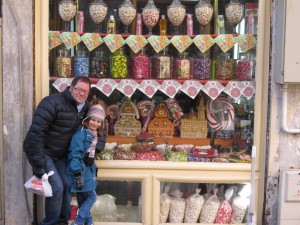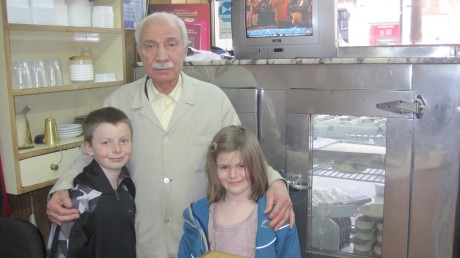A high point of our trip to Istanbul was the food. We literally ate our way through the city.
As java-philes, it took us a few days to adapt to being in a tea culture. Surprisingly, Turkish coffee appeared infrequently. But the black tea flowed continuously from samovars, and its scent permeated the air. We are not usually souvenir shoppers, but we purchased a set of the popular glasses that the Turks use to consume their tea as a memento (and because the funky curbed glasses made tea drinking extra fun).
On our second day we tried something novel: We signed up for a food tour. A group of young friends had started a web site called Istanbul Eats to ferret out the most spectacular offbeat culinary finds in the city. They soon found themselves receiving emails from people who had followed their blog requesting help guiding visitors to tiny purveyors around town. So they started putting tours together.
Seth and Nell enjoyed this amazing food tour (Eli was still not feeling well, so Jenny left the food tour halfway through to keep him company in the hotel). Our phenomenal guide, Megan, was an American graduate student finishing her dissertation in linguistic anthropology at the University of Chicago. She was fluent in Turkish, had been living in Istanbul for well over a decade, and was friendly with all of the cooks and purveyors that we visited. I knew we were off to a good start when, 20 minutes into what would turn out to be a seven hour eating tour, Nell pulled me aside to whisper “This is turning out to be a lot more interesting than I thought it was going to be.” After a full day of traversing the city, taking in both information and food, with our bellies aching even more than our tired feet, Nell said that it was by far the best tour she had ever done. I agree!
We began the morning by stopping at a street vendor for simet that had just been delivered in a bicycle-driven heated box. To describe these round, chewy bread rings as “sesame encrusted bread” or “Turkish bagels” doesn’t do them justice; their flavor and deeply satisfying texture is unlike any other carb we’ve tasted. It may be from the pekmez used in the batter (go Google that one!).
We went on to sample some local cheeses, but the real winner is what the Turks call, humbly, “white cheese,” which has the mouth feel of a combination of mild crumbly feta and rich cheddar. It appears on plates all day long, from breakfast through cocktails. We sampled a variety of olives, each one tasting distinct from the next, and then were ushered into a ‘secret’ hallway behind the Spice Bazaar to unwrap what we had purchased thus far and enjoy some tea with our breakfast. Nell discovered Turkish apple tea (which is not at all like the result of an apple-flavored tea bag) and it became her beverage of choice for the duration of our stay.
We next went to a small restaurant where local workmen duck in during the day for red lentil soup. The restaurant doesn’t serve anything else. And why would they? It was perhaps a perfect bowl of soup, with layers of flavor in each spoonful. After that we met a charming pide maker. Pide isn’t just a Turkish version of pizza. It is a thick oblong pita bread that, in our case, was covered with soft and hard white cheese and a spicy green pepper, covered with a raw egg, and baked quickly to order in a wood-burning oven. These canoe-shaped treats hail from Turkey’s Black Sea region.
Our next stop was Altan Sekerleme, the marble-top countered shop of a family that has been making candy since 1865, following the same recipe that was used to serve Ottoman rulers. The Turkish Delight was a sublime, sensual experience, as were the rows of tall glass containers of colorful hard candies in flavors such as bergamot and orange-cinnamon. We stopped into another secluded courtyard to sample some pistachio halvah and have some more tea, before visiting with an amazing doner sandwich maker and drinking fresh squeezed pomegranate juice.
Nell and I were surprised to find out how much we enjoyed Boza, a drink made from fermented millet (or bulgur). It has a reputation for building vitality that has been used by warriors and nomads since the 4th century– and would certainly not be to everyone’s taste. We had ours with cinnamon and roasted chickpeas sprinkled on top at one of Istanbul’s famous boza bars, established in 1876. It was so popular with locals of all ages—kids stopping in after school to the elderly—that we had to hustle across the blue tiled floor to grab a marble table.
We ended the tour in “Little Kurdistan” where we enjoyed a chopped shepherd’s salad with pomegranate molasses dressing, a hand-made walnut baklava, and kunefe. Kunefe is made by drizzling a row of thin streams of flour-and-water batter onto a turning hot plate, so they dry into long threads resembling shredded wheat. The “pastry” looks like long thin vermicelli noodle threads. The pastry is heated with some butter and then spread with soft cheese. A thick syrup, consisting of sugar, water and a few drops of rose water, is poured on the pastry during the final minutes of cooking. Crushed pistachios are then sprinkled on top as a garnish.
By Thursday, we were acutely aware that our opportunity for meals was rapidly diminishing (our flight to Rome was the next day). . . so we set about finding a few places that we were determined to try. Our lunch destination was Tarihi Karaköy Balikcisi, a small restaurant tucked away on a back street amongst vendors selling hardware that our food guru, Katie Parla, described as the best fish restaurant in town. We were advised to go at lunch when Maharrem Usta is working the charcoal. The unimposing restaurant was, in fact, so subtle that a shopkeeper who saw us standing in front of it looking around, came over to open the door for us—somehow he suspected we were in the neighborhood with lunch, rather than home renovation, in mind. We were ushered past the big barbeque pit on the first floor, up a narrow winding stairway, to a small table on the second floor. There, the owner brought over a large silver tray displaying each of the fresh fish being served that day. Eli decided to try the restaurant’s famous spigola cooked in parchment. Jenny and Seth followed what was rumored to be an excellent preparation—the sole on a stick, preceded by an exquisite fish soup. We left our plates spotless.
Despite that fact that we were feeling very happily satisfied after lunch, Seth needed to find Ozkonak—a real pudding shop. This was mostly because he had no idea what a pudding shop was, but liked the sound of it. This place has been in business for over 50 years, largely because of their tavuk gogsu, chicken breast pudding. (For the first time since 1982, Istanbul left Seth truly regretting his decision to not eat meat). He implored Jenny and Eli to order the pudding and describe it to him. The pudding doesn’t taste of chicken at all. We also ordered a thick, creamy rice pudding dusted with cinnamon, and a bowl of home made unusually thick yogurt (that was Nell’s favorite). And as we were leaving, we asked the owner if we could take home a portion of kaymak(the delicious Turkish version of clotted cream made from the milk of water buffalos) to save for breakfast the next day. It was amazing!
For dinner, we again followed one of Katie Parla’s suggestions and tried Asmalı Cavit in Beyoğlu. This restaurant is what is known as a meyhane: a casual restaurant serving raki (the Turkish national drink of anise-flavored brandy that both Seth and Jenny ended up loving) and mezes (starters). The mezzes were displayed like a dim sum restaurant: they are wheeled from table to table on a multi-decker tray, and are simple and deliciously fresh dishes. We tried watercress in yogurt, fava beans, aubergine spread, hummus, roasted peppers, kale, grilled shrimp, patlıcan salatası (smoked eggplant with a touch of bechamel), and beyaz peynir (white cheese), among others and fantastic bread.
A few of our other favorites over the week:
Eli loved the kebaps, perfectly grilled over charcoal, especially the chicken wing ones.
At the Grand Bazaar we tried sahlep, a hot drink made from orchid roots and served hot with cinnamon. We also ate at a fantastic restaurant hidden away in the enormous bazaar, Havuzlu. There, and also at the wonderful Ciya restaurant on the Asian side of the Bosphorus, you order by going up to the counter, overviewing the dishes of food, and just pointing to the ones you want to try.
Seth enjoyed a cold drink called ayran, a mixture of water, yogurt and salt.
We all loved the fresh juices sold everywhere, especially the orange and winter pomegranate that is fresh squeezed on the street (winter pomegranate is uglier and yellower than the pomegranate we usually see in the US- but also much sweeter).
Nell’s favorite dessert was found on the Asian side: a stall in the food market selling cups of thick yogurt that were drizzled with honey direct;y from huge honeycombs.
Jenny could happily live on the pistachio and walnut baklava.
Food Coordinates Below–>
Eating at the Grand Bazaar:
Havuzlu, Gani Celebi Sokak No. 3
Eating on the Asian Side:
Ciya, Guneslibahce Sk, No. 43
Filled with tourists, but decent vegetarian and kabop option near Ayasofya:
Khorasani, Divanyolu caddesi Ticarethane sokak No. 39/41
Meyhane in downtown (near the pedestrian street):
Asmali Cavit Saatci, Asmalimescit Cad., No. 16 D
Pudding!:
Ozkonak, Akarsu Cad., No. 46/B
The best fish restaurant ever (in Karakoy):
Tarihi Karaköy Balikcisi Lokantasi, Tersane Cad. Kardesim Sok No. 45/A
The real-deal for boza:
Vefa Bozacisi, Celebi Caddesi, 102
Amazing yogurt at the Asian side food market:
The Sultan’s candy maker (and the best Turkish Delight):
Altan Sekerleme, Kantarcilar, Kiblecesme Cad., No. 96
Baklavaci Extraordinaire:
Bilgeoglu, Muvakkithane Cad., No. 56














Wow. You guys really know how to travel! You have also made me too hungry to keep holding office hours, so I’m leaving now.
Seems like you guys are having a great time! I’m jealous of both your travels and the fact that your kids like to eat!